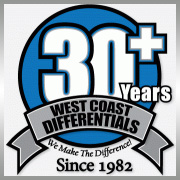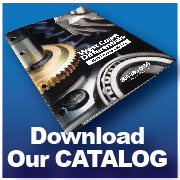
Differential FAQs – Common Differential, Gear and Axle Topics
The following Differential FAQs are a few of the most common Questions we receive. Our staff of Differential Experts is ready to help with your specific axle and differential questions Monday thru Friday from 8am to 5pm Pacific Standard Time.
Differential FAQs – What gear ratio do I need?
 Differential Gear Ratio determines the number of times the drive shaft (or pinion) will rotate for each turn of the wheels (or ring gear). So if you have a 3.73:1 gear ratio the drive shaft turns 3.73 times for every turn of the wheel.
Differential Gear Ratio determines the number of times the drive shaft (or pinion) will rotate for each turn of the wheels (or ring gear). So if you have a 3.73:1 gear ratio the drive shaft turns 3.73 times for every turn of the wheel.
Gear ratio is calculated by dividing the number of teeth on the ring gear by the number of teeth on the pinion gear. The higher the number, the lower the ratio: a 5.29 gear has a lower ratio than a 4.10 gear. With a lower gear ratio the drive shaft (and thus the engine) turns more for each revolution of the wheel, delivering more power and torque to the wheel for any given speed. Lower ratios are generally desirable when going off-road. Higher ratios are better for freeway driving since they run at lower RPM’s and offer better fuel economy.
Changing tire size affects the final drive ratio. Switching from a 30″ tire to a 35″ tire changes the final drive ratio by about 17%. This may drop the engine out of its’ “power band” and result in poor performance and fuel economy. To restore performance you must change the gear ratio to compensate for the change in tire size. If you originally had 3.07 gears you need a ratio that is approximately 17% lower, such as 3.55. If you want to increase off road performance you might want a 4.10 or lower ratio.
Differential FAQs – Formula for Calculating a “Return to Stock” Ratio after adding Larger Tires:
The formula for determining an appropriate gear ratio is fairly simple. Divide the New Tire Height (measured in inches or CM) by the Old Tire Height, then Multiply by the Original Gear Ratio.
New Tire Height / Original Tire Height X Original Ratio = Return to Stock Ratio
Example:
35″ / 31.9″ = 1.097 X 3.08 = 3.37
Notice that the new corrected ratio is 3.37, which doesn’t actually exist This is merely your starting point. In most cases, the nearest available ratio will be 3.42 or 3.55.
But, there are a few other factors to consider before choosing the ideal ratio. Firstly, your new big tires probably weigh more than the old stock setup. Secondly, wider tires and a taller vehicle create more wind resistance. To compensate for this, you might want to choose a ratio that is at least one or two steps lower (higher numerically) such as 3.73 or 4.11.
Another factor to consider is how you intend to use the vehicle. For a primarily flat-ground high speed highway driven vehicle, the 3.73 or 4.11 might be just fine. For a vehicle that sees a lot of hills and more off road use, 4.56 or even 4.88 might be appropriate. Use our Calculators page to see how the different ratios affect engine RPM.
Recommended Engine RPM @ Highway Speed
- 4 cylinder: 2200 – 3200
- V6 cylinder: 2000 – 3200
- Small block: 1800 – 2800
- Big block: 1800 – 2600
- Diesel: 1600-2800
Check out our handy calculators!
Explore the different Gear Ratios available for your vehicle in our Online Catalog
Differential FAQs – Do I need a positraction or a locker?
Most vehicles come from the factory with an “open” differential. The open differential is designed to propel the vehicle while also allowing for one tire to be turning faster than the other. (During cornering, the tire on the outside of the corner travels a longer path than the inside tire) This design provides smooth cornering with no adverse tire wear. In a low traction situation (i.e.: one tire on mud or ice) the open differential will apply power to the tire with least traction, resulting in tire spin and no forward propulsion.
Positractions / Limited-Slips:
A limited slip or positraction differential typically uses some form of clutches that bind up the differential, providing traction to the both tires. The clutches will slip to some extent to allow tires to turn at different speeds on corners. Some limited slip differentials are more aggressive than others, and some can be set up or “pre-loaded” more or less aggressively. Limited slip units require a special gear oil additive and may chatter when turning. Clutch packs may also wear with time and require replacement.
Locking differentials come in various forms, all of which provide 100% traction to both wheels. Automatic locking differentials, such as the Detroit Locker or Lockright require no driver input whatsoever. Selectable lockers such as the ARB Air Locker, Eaton ELocker and Auburn ECTED typically perform as an open differential until the driver selects “locked” mode.
Spools:
A spool has no moving parts, and basically turns the driver and passenger side axles into a single axle shaft. No provision is made for cornering so tire chirp is unavoidable. Spools are best suited for racing-only applications
For complete listings of the Positraction Units and Locking Differentials available for your particular vehicle or application, consult our parts catalog located at the top right of this page.
Explore the
Differential FAQs – What gear ratio do I have?
The easiest way is to use identifying tags, Bill of Material information or RPO Codes. This method is detailed in our Differential Identification page. Another option would be to inquire at your local dealership using the VIN number. All of these methods are accurate, provided the previous owner has not changed the ring & pinion gears to a different ratio.
If the tags are missing or you suspect the ratio may have been changed by a previous owner, follow the steps below to determine the ratio, OR you can open the differential and count the teeth on the ring gear and pinion gear.
First: Determine whether you have an open or locking differential/positraction. (Skip this step if you already know) With the transmission in neutral or driveshaft removed, lift both rear wheels off the ground and rotate one wheel. If the other wheel rotates in the opposite direction or not at all and the driveshaft does not turn, your differential is open or you have a worn out posi. If both tires rotate in the same direction, you have a locking differential, functional posi or spool.
If neither rotates, double check that the transmission or transfer case is in neutral and the parking brake is released.
Open Differential Gear Ratio Test: Make a visible mark on the driveshaft or pinion yoke. Jack up one side and rotate the tire 2 complete rotations while carefully counting the number of full rotations the driveshaft or pinion yoke makes. The number of rotations of the driveshaft will indicate your ring & pinion gear ratio. For example, 3 ¾ rotations means you have a 3.73 gear ratio. TIP: Double the number of tire rotations and divide the result by two for a more accurate result. If you are unable to rotate the tire with only one side in the air, proceed to the Locking Differential or functioning posi gear ratio test below.
Locking Differential or functioning Posi Gear Ratio Test: Make a visible mark on the driveshaft or pinion yoke. Jack up both sides and rotate one tire 1 full revolution while carefully counting the number of full revolutions the driveshaft makes. This is your gear ratio. In other words, if the drive shaft turns 3 ¾ turns, you probably have a 3.73 gear ratio. TIP: Double the number of tire rotations and divide the result by two for a more accurate result.
Differential FAQs – Do I have a posi or a locker?
Put the transmission in neutral and jack up both tires. Turn one tire. If the other tire spins the opposite direction you have an open differential, and if it spins the same direction you have a posi or a locker.
Check Out Our Products
Order by Phone
Need your parts ASAP?
For the fastest service, call our Differential Parts Experts at (800) 510-0950 for immediate assistance. We are available to help Monday thru Friday from 8 AM to 5 PM Pacific Standard Time, and most orders placed by 4 PM ship out the SAME DAY!
Contact Us
For inquiries about our products and services, please fill out the form below. We look forward to serving you!


 West Coast Differentials has been distributing quality differential and axle parts since 1982. We believe that our exceptional customer service and product knowledge is what sets us apart from the competition. Give us a try, we think you'll be glad you did!
West Coast Differentials has been distributing quality differential and axle parts since 1982. We believe that our exceptional customer service and product knowledge is what sets us apart from the competition. Give us a try, we think you'll be glad you did! The most current parts and application information can always be found here on our website or by calling one of our differential parts experts. All of the parts we sell are also used every day in our busy service shop. This gives us confidence in the quality of the parts we sell.
The most current parts and application information can always be found here on our website or by calling one of our differential parts experts. All of the parts we sell are also used every day in our busy service shop. This gives us confidence in the quality of the parts we sell.